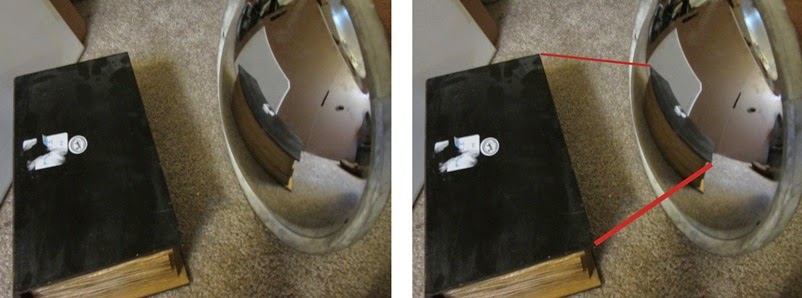The shape of a highlight is determined by the shape of objects in the environment surrounding the form that a highlight is seen upon and by a viewer's spatial relation to those factors. Since specular reflection is a mirror-like reflection of light, the light that is diffusely reflected off of the objects in the environment has an impact on the shape of highlights seen on a form.
For example, the mirror above shows a reflection of the environment that surrounds it because of the light that each object in the environment is first reflecting diffusely and then reflecting specularly on the surface of the mirror. Diffuse reflection occurs by light from a light source striking an object and then reflecting in various directions. In the instance of the above mirror, the light rays that are diffusely reflected from the book strike the mirror and are visible at the halfway point between the angle of incidence of the light rays and their angle of reflection into a viewer's eye. The diagram above shows the extremities of light rays that are diffusely reflected from the book's corners and where they are visible on the mirror. The shape of a form determines just how much of the environment will be specularly reflected on it. The form of the convex mirror, in the diagram shown above, only reflects the parts of the environment that it faces.
Examining Highlights on Eyes
Taking a closer look at the eye in the portrait drawing above, one can see that I was trying to represent the specular reflection of the environment in the model's eye. Although the human eye is not as large as the convex mirror, shown above, it certainly exhibits specular reflection in a similar way that a convex mirror does. One difference between the two is that the human eye is colored. The color of different parts of the eye influences how visible the specular reflection will appear on it. For example, the table is actually brighter in the environment than it appears on the model's eye, but its brightness is diminshed in intesity on the iris of the eye due to the dark color of the model's iris.
Examining the Shape and Size of Highlights
The shape and size of the objects reflected in the eye are determined by the shape of the form that is exhibiting specular reflection, the shape of the objects in the environment and a viewer's spatial relation to each of those factors.
The shape of the form determines the distortion of the objects that are speculary reflected on it. The diagram above shows how the shape of the light source conforms to the shape of the form that it is specularly reflected upon.
here. I have found it very useful to evaluate the shapes of highlights by examining highlights in this way.
Examining Highlights on Skin
 |
| A microscopic view of the texture of skin. Note, pores are not actually shaped like squares. But it was easier to draw squares for this diagram. |
The brightness of the highlight on each of the pores is a result of how directly the light source is striking them. For example, the pores, at the bottom of the form, that are furthest away from the largest angle of incidence and reflection are the darkest. This is due to the small amount of surface area on those pores that the light rays from the light source can reach.
Taking a closer look at the nose on the drawing shown above, one can see that I was trying to represent the shape of the highlight on the model's nose. Since highlights on human skin are broken up by areas of flesh, the shape of the highlight on her nose is not as crisp as it would be on a smoother surface such as the human eye. Also, the color of the form that exhibits specular reflection influences how visible a highlight is seen on it much in the same way that the color of the model's iris influenced how visible the parts of the environment could be seen on the eye. Even though the entire environment is specularly reflected by the nose, the only object that the nose is obviously reflecting specularly is the light source because it is so bright.
Although this type of analysis of highlights may seem to be over extensive, many of the factors that highlights adhere to often appear so subtle that they can be overlooked and represented out of place. But when highlights are accurately represented an incredible illusion can be conveyed. I hope to reach that quality one day, but so far the thought processes discussed in this post have been my most useful tools for examining highlights while working on my drawings. Although the drawings, shown below, are unfinished I am including them in this post to show how I have been trying to incorporate these thought processes into my drawings.







2 comments:
This is one of the better classical painting instructional sites I've come across.
Fine work, too.
Thank you so much for your kind comments Carrie Ellen Christian. I really appreciate your support and encouragement.
Post a Comment